On June 6th I was part of a panel at the Art Gallery of Ontario brought together by curator and writer Sarah Milroy. It was also the week the Truth and Reconciliation Commission made its report. Here is what I had to say about Carr and her legacy.
My thanks to Sarah Milroy for the invitation to be part of this gathering today. I would like to note that though I’ve spoken here at the AGO on several occasions — it was usually outside the front door and at a protest — this is the first time I have actually come by invitation. And I’d like to acknowledge that fact.
It is also many years since I swore off talking about Emily Carr. At least in public. Following the publication of my book The Laughing One in 2001, I did a national tour, (of radio, Television interviews), appeared at readings and festivals and author’s luncheons. The rush of activity that normally abates after 3 or 4 months — only in this case it didn’t. I continued to get requests from students, collectors, psychiatrists, other writers, dealers, academics and Carr fans. All welcome although the volume was intimidating at times. When I started receiving letters addressed to Emily Carr, though, I decided it might be time to leave her and her legacy to others. (The exception has been the two collaborations with Maliseet artist and writer Shirley Bear about Carr and Sophie Frank.)
More salient for us today — and as someone who spent an entire decade thinking about Emily Carr and following her around the Northwest Coast of British Columbia — I have to thank Sarah, and commend her for the gift of this exhibition. I’ve seen a lot of Carr but I have to say I’ve never seen her quite like this. I find it remarkable what a open, intuitive and intelligent curator can draw out of the mish-mash of history, legend and make-believe that attends Carr’s legacy. Still. In Sarah’s hands I feel we are finally getting an unobstructed view of Carr the artist : the unapologetic colourist of the post-Paris years, the expert draughtsman’s singing line, the deep rhythm of those forest interiors let loose, and the vision at the end when, as poet George Stanley puts it, she was painting air.
If I may, I’d like to also acknowledge some of the people who assisted Sarah in the creation of this thoughtful celebration of Carr’s work : Kristina Ljubanovic designed the installation. Aleks Grzywaczewska designed the graphics. Craig Whiteside and Ben Oakley were the primary Installers. Ruth Jones, Jacques Oulé, Jason Laudadio and Randal Fedje also helped at times. Paul Mathiesen did the lighting.
The Journeys of Emily Carr
To preface my comments about the two paintings I’ve chosen to speak about, let me admit that what drew me to Emily Carr was not her paintings. ((Totem Mother (1928) and Guyasdoms D’Sonoqua (1930).)) Originally it was her writing, and specifically the descriptions of her first attempt to move out of the isolated outpost that was Victoria one hundred and fifteen years ago, to study in England and a few years later in France. Both times she fell seriously ill and had to return home. The opinion of people at the time and most writers since is that she was suffering some kind of emotional breakdown. The doctor at the clinic in the UK called it hysterics. However, reading her journals in the sixties and knowing nothing of this, I totally understood her predicament and having had similar experiences living in Europe which forced me to conclude people do not always thrive physically in foreign places; even healthy people, even in fabulous and fascinating foreign places like Paris or Florence.
What struck me then was how miserable Carr was travelling; what surprised me was her dogged determination to do go back to Europe a second time in 1910. What kept her going? Once back in Canada, moreover, she was at it again. This time she struck out even further afield making the first sketching trip to First Nations communities up the coast the summer after her return from France. These journeys were of a different order than her sojourns in Europe which had been in search of training, and exposure to other artists exploring modernist trends. This was a quest for her own roots in Canada, and it had already drawn her to the carvings and designs of the Indigenous peoples. In 1906 she’d struck up a friendship with Coast Salish basket maker Sophie Frank and began visiting her on the reserve across second narrows in North Vancouver. (A connection that lasted until Sophie’s death in 1939)
Carr was no thrill seeker, and not much of an adventurer though she was certainly intrepid. But beyond her unwavering dedication to her work, she had a private mission which was to put distance between herself and the transplanted culture of her English parents which she found hypocritical and confining. A culture, after all, which saw the mountains as ugly, and Native culture as barbaric. Her openness to Aboriginal culture can be understood, in part, as a flight from her own background. Without leaving the continent, moreover, she could travel into realms that were utterly unfamiliar to her; and a long way from polite society. She opened up to difference and plumbed it for depth.
More significantly, she spent time in communities not only radically different from hers, but radically under siege from Canadian authorities and the white settler society around them. These were the Visitors who Never Left. Visitors and they included Emily — as, indeed, they include most of us in this room.
Carr was invigorated by her journeys — and terrified. Frightened at the prospect of what she’d meet, and happy with what she was finding. Both states of mind are recorded in her writings, and visible in these two works. On the one hand, the bear figure at the base of a pole at Gitanyow which she saw as a metaphor for motherhood, and on the other, the huge and menacing D’Sonoqua. Carr knew she-he (for the D’Sonoqua is both male and female) was an important figure to the Kwakwaka’wakw, and she tells of her own spectacular encounter with a figure like this one near Gwyasdums. It was raining, she slipped on sodden earth and wet salal ending up on her back staring at those hearts-shaped breasts. She is spooked. She has dreams of the D’Sonoqua. Admits she yearns to see one, even to hear the whooshing sounds (from those pursed lips) as she comes crashing through the forest like the wind. Yet she dreads it from bottom of her soul.
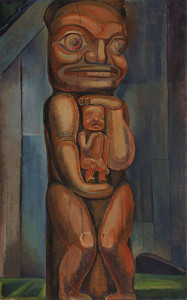
Totem Mother
When I first saw thispole in Gitanyow in the early 1990s, it recalled for me this image painted by Carr in 1928: the tight focus, the large, ungainly paws with tiny human-soul between them. When I see the painting now, though, I remember Freda Diesing. It was Freda who took me to Gitanyow. I’d called her up to see if she was around (she had a house in Rupert, a second place in Terrace and she floated back and forth between them) as I was heading up her way. She said I should come visit her and she’d show me her poles. I’d seen a few of her famous portrait masks, and had spent some time with her in Toronto when an exhibit of Native women artists lunched the International Congress of PEN in 1989, so I knew she’d carved several poles, one in Kitsumkalen, another in Rupert. As it turned out, Freda actually meant all the poles along the Skeena that she’d learned from. And that was quite a number.
Over several days we drove up and down that stretch of Hwy 16 to the K’san Village where Frida had worked for a while, and on up to Kispiox. One by one she introduced me to ‘her poles’. We’d stand together and she would read them, moving from the bottom up through the narrative, pointing out details, telling me about the pole itself and what she liked about it, who carved it and for whom. She was Haida, but had lived along the Skeena all her life. There weren’t many new poles then; those at Gitanyow were decades old and very weathered. Some had turned dark with age, but the most impressive one by far — the Hole in the Sky pole which Frida said was the oldest pole still standing on the Coast — was a brilliant, silvery white.
We talked of many things over those days. I learned about her life and her mother’s. Both married out to white men who succumbed to TB; Frida contracted it herself in her 20s, the aggressive x-ray treatment leaving her unable to have children. “They fried my eggs”, she joked. Although her grandmother was a noted Haida carver (known as a carver of canoes), and a master maker of spruce root baskets, it was a very long, tough road for Freda and other Native women wanting to be artists in the 1950s and 60s. The brilliant Daphne Odjig notwithstanding. Freda started late. And some talented women, she noted, never got started at all. We talk of that, too. For Frida and I were, of course, driving the stretch of highway in northern B.C. now widely known as the Highway of Tears. These were the years when a few people had begun to sound alarms about the missing and murdered Native women and girls. Writer and activist Mary Billy in Squamish had been keeping a list for several years, publishing the results in the newsletter that she sent out to feminists and writers all over BC ; the count was in the hundreds even then.
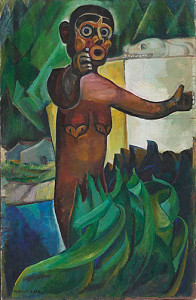
D’Sonoqua
This image of the D’Sponqua — well, just the name, actually — invariably yanks me back to the afternoon I spent with Agnes Hunt Cranmer in her kitchen in Alert Bay, as she dried halibut, and patiently repeated the word for me, while I attempted to pronounce it. It was mother’s day weekend and I’d brought flowers and greetings from my friend Joan Skogan, a white woman who married-in and lived there for a time. Agnes Cranmer was the widow of Dan Cranmer, the man who gave the famous potlatch on Village Island in 1922 the one that was busted and led to the first conviction won by the Crown under the anti-potlatch laws. (Since 1884 some 150 indictments had been issued, but the charges were all either thrown out or sentences suspended.) This result this time? Twenty-six participants including grandmothers sent to jail in Burnaby, and the confiscated carvings sent east and (eventually) into museum collections. But, I must note, getting that conviction required some rigging in the form of an amendment to the Indian Act allowing prosecutors to act as judges.
Ninety-three years later, our Chief Justice Beverley McLachlin, in her speech last week to the Global Centre for Pluralism mentioning this law, called Canada’s treatment of Indigenous peoples Cultural Genocide. Some quibble with the term, or shy away from it by declaring we are not the responsible generation (even though the last residential school only closed in 1996), and I think we have to remind ourselves that none of us get to pick our ancestors. Honouring them means accepting the bad among them, along with the good. Acknowledging this national shame, as Doug Saunders wrote in the Globe this morning, does not have to define us. What we do now though, I think will.
Like Carr, I approached my journeys up the coast with a mixture of anticipation and extreme anxiety. I’ll say it. Fear. Of course, there was no way I could presume my way into Native communities armed with good will and ignorance as Carr did. Those communities are, for one thing, very used to white people showing up with something on their minds. They’ve seen it all — had the missionaries, Indian agents, anthropologists, residential school administrators, politicians, judges, and the police. And recently journalists and environmentalists had joined the list. So I had to be very clear what I was doing there. Whose history was I proposing to write. What I expected from my hosts and the people I met, and what I offered in exchange. Above all, I needed to school myself on the history that wasn’t taught in school and university. The history of contact as recounted by Native historians writers and artists, and a younger generation of storytellers. Very quickly I learned two things. First that I could only do this with accomplices. One or two people who could and would be guides, or counsellors — there really isn’t a word for their role which was intellectual and spiritual, though I’d say the main ingredient was friendship. And second, that there were going to be two sides to my journey, one that I would write about, and one I would not. (Although I do recount the time Lee Maracle called me out on co-op radio.) In other words there was the non-public side to the evolution of my thinking and understanding, experiences that made it possible for me to write what I did.
By now the history of contact includes Supreme Court cases that have been won by Aboriginal litigants, Delgam’ukw and Tsilhqot’in among others. And it is obvious that Indigenous communities have defied the fate assigned them by Emily Carr’s generation. Carr writes with pathos about Sophie Frank’s twenty-one dead children; babies born and gone in a matter of months, a cycle repeated with horrific regularity. Carr witnessed this hardship up close, saw Sophie’s return to prostitution, and drink; tried not to be judgemental. And in the end, could not resolve the contradiction between what she perceived in the magnificent carvings and what she saw Sophie having to endure.
My last trip to Haida Gwaii was with Shirley Bear when she was Aboriginal student advisor at Emily Carr College in Vancouver. She and a friend from back home who was investigating the different ways communities were accommodating the return of ancestors’ bones from museums, were going to Skidegate to stay with Dianne and Dull Brown, and Shirley suggested I tag along. She’d heard there were still Carr stories about, and people who remembered her. Shirley is not a fan of Carr’s, I must tell you; but while I was researching and travelling we talked. She and her family were living in Vancouver then and she had a studio down on Parker Street for several years where we hung out for long hours. It was a time of intense debate about appropriation, especially in the women’s community, particularly about the appropriation of voice in writing. (The controversy that split the Women’s Press.) We talked about appropriation in regard to Carr, and in particular in relation to Sophie Frank, and the manner in which she presented Sophie to the world. The result was our performance piece Dear Sophie / Dear Emily which we originally did at the Vancouver Art Gallery. Based on letters Sophie wrote to Emily and Carr’s writings about Sophie, we billed it as a conversation about art, appropriation and friendship. Part of the piece was improv; we’d leave the script and carry on as the two characters. And then we speak as ourselves, pursuing the conversation in the present tense, inviting the audience to join in.
Shirley lives in Noogootkook, the reserve called Tobique on the Aroostook River that flows into the Saint John. A woman who’s well known across the country as an artist, feminist activist and writer, her reputation cuts across many communities and she has a tremendous following (and, I should add, an Order of Canada). Her renown is partly because of the role she played in the repeal of the infamous clause in the Indian Act that stripped Native women of their status when they married out. She’d returned to her home to stay with her mother in Tobique with two small children when her marriage to a white man ended and she’d no place else to go. In due course she was told she’d no right to be in her mother’s home, and had to leave. On Christmas Eve, Shirley and a small group of women occupied the Band Office, joining a larger group of dissenters who were refusing to be thrown off other reserves. It was a huge grassroots campaign, and in 1985 12 (1) (b) was removed from the Indian Act .
But not without the addition of a new prohibition limiting women’s ability to pass on their native status. The remedy is actually worse. An estimated 40,000 children have been denied status because their fathers are unknown or unidentified. And another decision was just handed down this week, as another Native woman is denied Native status. ((The suit was brought against the Attorney General of Canada by Lynn Gehl. For information and background see http://www.lynngehl.com/. Decision Citation: Gehl v. Canada ONSC 3481 Court File No. 02-CV-237750CM3.)) Canada being the only country in the world which still has a department responsible for deciding the racial purity of (some of) its citizens. As constitutional and human rights lawyer Mary Eberts puts it, “For me, it’s a sign that colonialism is alive and well; Canada is still using bureaucratic means (the registration system) to reduce numbers of status Indians in the hope of making ‘the Indian Problem’ go away.” In her considered opinion Native women in Canada have been designated as prey. Legally speaking they are targeted, and, as we have witnessed in our time — don’t forget, before the serial murdering pig farmer, there was the serial murdering barber operating in the downtown eastside of Vancouver — our Native sisters can be killed with impunity.
I wrote The Laughing One because I wanted to look at what Carr did in her life, most especially her choice to depict the Native villages she visited, including in her paintings the distinctive carving on houses, poles, and canoes, and her choice to use indigenous designs on the clay pots she made for the tourist trade. She criticized others for doing this, claiming special status for herself as someone who knew and understood them — both the designs, and the native people. I first wanted to understand what she actually knew — and there was a fair amount in the archive that had not been published indicating she was no naïf on the subject of appropriation, and that she’d run into Native people who objected to her painting their poles. Eventually, the outtakes from the published record (mainly from Klee Wyck, andthe journals Hundreds and Thousands) were published in Opposite Contraries which I always have seen a testament to the effort, as recent as the 1960s, to clean-up Carr’s record by removing the unsightly references to suffering Native women.
Carr’s original purpose in making these trips had been to document the carvings as a kind of momento mori of a disappearing culture; when that idea got nowhere, she painted them for herself, integrating them into her larger preoccupation with landscape. In the 1930s she started writing about her travels and the Native people she’d met along the way. It is as a result of these renditions of contemporary Native life, that the issue of Native Rights and Settler Society wrongs have come down to us as part of Carr’s legacy.
My book — which is subtitled “A Journey to Emily Carr” — is about Carr’s relationship to Indigenous peoples, but it is also about our relationship today; the relationship to the shared history of Native and Non-Native Canadians. Carr will remain a problem for us until we deal honourably and appropriately with settler Canada’s obligations to all Indigenous communities — starting with acknowledgement and including reparations. Until we do that, I for one don’t feel comfortable claiming Carr as a national icon. Put more positively I ask, if she is to be a National Icon what does she stand for? What do we see in her life and work that addresses our founding communities — Native and non-Native?
I think the answer might be this: To the extent that Emily Carr and Sophie Frank embraced a friendship despite the disparity between them, I believe they are a model for us. A model of two people forging a personal connection across cultural/racial divides without permission or protocol. Like dancing in the dark; like creating into the future. Like imaging a fair resolution to historic injustices, and recognition of their present-day manifestations. My guess is that Carr wore her heart on her sleeve where Sophie was concerned and Sophie saw there a deep well of caring; more significantly, Emily encountered in Sophie — and in her community — a generosity and acceptance that was heartening beyond words to her, and palpable encouragement.
In the last five years, besides the Tsilhqot’in decision, we’ve seen the Truth & Reconciliation Commission set up, complete its work and make its report. The comments of Justice Murray Sinclair of the Commission this past week demonstrate that self same generosity Emily experienced, that I have, and I daresay that many of you have too. And it’s a generosity that I feel the non-Native community of Canadians has never really earned.
Thus far reconciliation has been left pretty much to Native people themselves, along with a few guilty Churches. Yet reconciliation is demonstrably not something that can be delegated. I believe Chief Justice McLachlin’s remarks take us a giant step along the path to Reconciliation. And clearly, the timing of this exhibition is fortuitous. We are at the perfect moment in history to be revisiting Emily Carr and her legacy.
I’d like to end with this observation : That the work of Indigenous artists, writers, musicians, and performers has been, and continues to be, central to the work of healing within the Native communities. They have also increasingly been reaching out to non-Native communities, working with non-Native artists, and I wish to pay tribute to their patience, their generosity, their humour — and their faith in us.
Thank you.
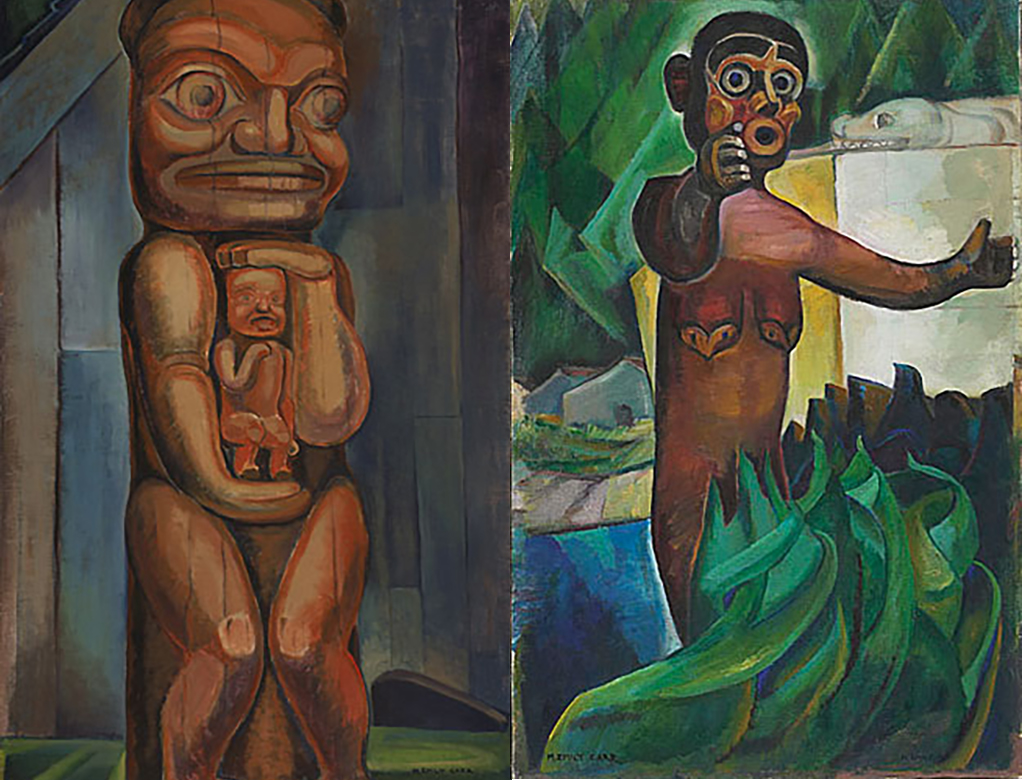
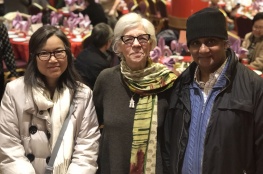
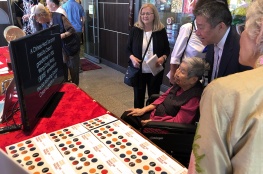
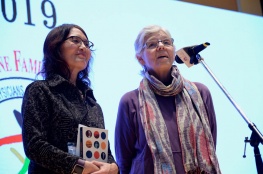
June 16, 2015
Thank you Susan. There are so many worthy thoughts and facts and the spirit you bring to this is generous and hopefully will contiune to grow support for the many truths so long denied.